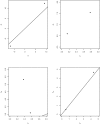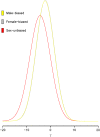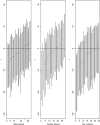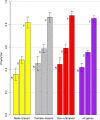Inferring the distribution of selective effects from a time inhomogeneous model
- PMID: 30657757
- PMCID: PMC6338356
- DOI: 10.1371/journal.pone.0194709
Inferring the distribution of selective effects from a time inhomogeneous model
Abstract
We have developed a Poisson random field model for estimating the distribution of selective effects of newly arisen nonsynonymous mutations that could be observed as polymorphism or divergence in samples of two related species under the assumption that the two species populations are not at mutation-selection-drift equilibrium. The model is applied to 91Drosophila genes by comparing levels of polymorphism in an African population of D. melanogaster with divergence to a reference strain of D. simulans. Based on the difference of gene expression level between testes and ovaries, the 91 genes were classified as 33 male-biased, 28 female-biased, and 30 sex-unbiased genes. Under a Bayesian framework, Markov chain Monte Carlo simulations are implemented to the model in which the distribution of selective effects is assumed to be Gaussian with a mean that may differ from one gene to the other to sample key parameters. Based on our estimates, the majority of newly-arisen nonsynonymous mutations that could contribute to polymorphism or divergence in Drosophila species are mildly deleterious with a mean scaled selection coefficient of -2.81, while almost 86% of the fixed differences between species are driven by positive selection. There are only 16.6% of the nonsynonymous mutations observed in sex-unbiased genes that are under positive selection in comparison to 30% of male-biased and 46% of female-biased genes that are beneficial. We also estimated that D. melanogaster and D. simulans may have diverged 1.72 million years ago.
Conflict of interest statement
The authors have read the journal’s policy and have the following conflicts: SZ received support from Santander Bank in the form of a salary. This does not alter our adherence to PLOS ONE policies on sharing data and materials.
Figures




Similar articles
-
Prevalence of positive selection among nearly neutral amino acid replacements in Drosophila.Proc Natl Acad Sci U S A. 2007 Apr 17;104(16):6504-10. doi: 10.1073/pnas.0701572104. Epub 2007 Apr 4. Proc Natl Acad Sci U S A. 2007. PMID: 17409186 Free PMC article.
-
Bayesian analysis suggests that most amino acid replacements in Drosophila are driven by positive selection.J Mol Evol. 2003;57 Suppl 1:S154-64. doi: 10.1007/s00239-003-0022-3. J Mol Evol. 2003. PMID: 15008412
-
A reanalysis of protein polymorphism in Drosophila melanogaster, D. simulans, D. sechellia and D. mauritiana: effects of population size and selection.Genetica. 2004 Mar;120(1-3):101-14. doi: 10.1023/b:gene.0000017634.17098.aa. Genetica. 2004. PMID: 15088651
-
Patterns of polymorphism and divergence from noncoding sequences of Drosophila melanogaster and D. simulans: evidence for nonequilibrium processes.Mol Biol Evol. 2005 Jan;22(1):51-62. doi: 10.1093/molbev/msh269. Epub 2004 Sep 29. Mol Biol Evol. 2005. PMID: 15456897 Review.
-
Comparative analysis of morphological traits among Drosophila melanogaster and D. simulans: genetic variability, clines and phenotypic plasticity.Genetica. 2004 Mar;120(1-3):165-79. doi: 10.1023/b:gene.0000017639.62427.8b. Genetica. 2004. PMID: 15088656 Review.
References
MeSH terms
LinkOut - more resources
Full Text Sources
Molecular Biology Databases

